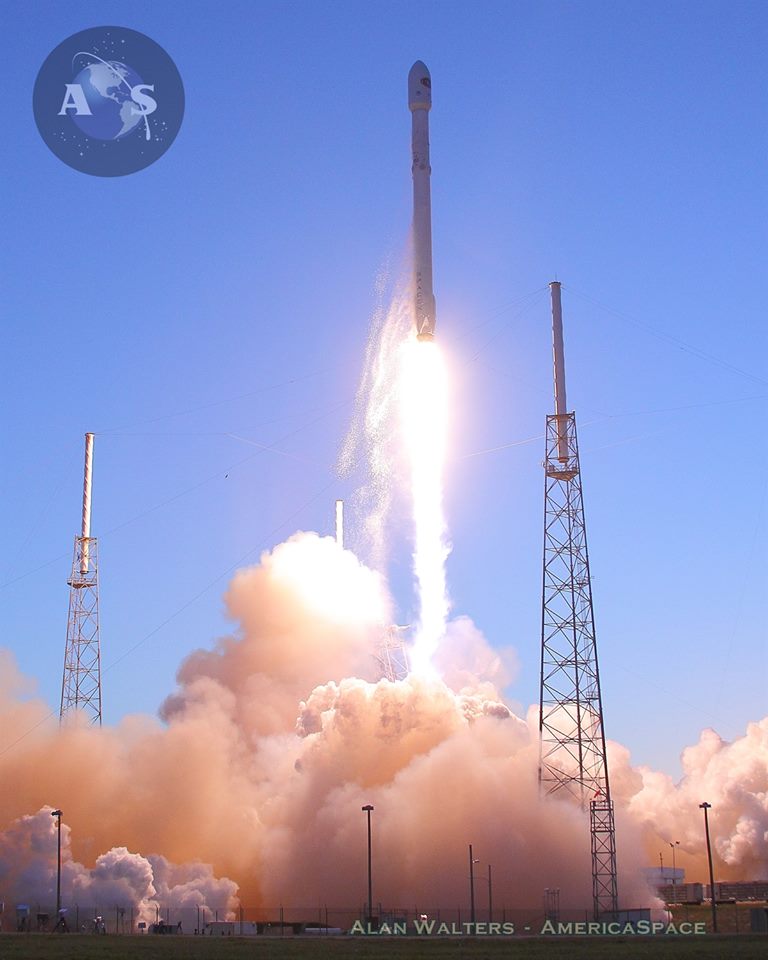
Following two scrubs in three days, caused by a combination of problematic high-level winds and a glitch with an Air Force Range radar asset, Wednesday proved third time lucky for SpaceX, as it successfully launched its second Falcon 9 v1.1 booster of 2015 from Space Launch Complex (SLC)-40 at Cape Canaveral Air Force Station, Fla. Restricted to an “instantaneous” launch window—as dictated by the nature of its primary payload, the Deep Space Climate Observatory (DSCOVR), a joint partnership between NASA and the National Oceanic and Atmospheric Administration (NOAA)—everything seemed at last to fall into place for SpaceX and the Falcon rose from Earth at 6:03:32 p.m. EST, powered by 1.3 million pounds (590,000 kg) of thrust from its nine Merlin 1D first-stage engines. Despite the disappointing news that high seas precluded a landing atop the Autonomous Spaceport Drone Ship (ASDS), the launch of DSCOVR marks SpaceX’s most distant mission to date.
As described in AmericaSpace’s DSCOVR preview article, the 1,250-pound (570-kg) payload has been placed onto a trajectory which will carry it by the end of May 2015 to the L1 Lagrange Point, about 930,000 miles (1.5 million km) beyond Earth, where the gravitational influence of the Home Planet and the Sun meet in near-equilibrium. From this unique location—which has also been occupied by the International Sun-Earth Explorer (ISEE)-3 and the Solar and Heliospheric Observatory (SOHO)—the DSCOVR spacecraft will spend at least two years performing measurements of the Sun in support of space weather requirements, providing three-dimensional analyses of the constituents of the solar wind and undertaking observations of the entire sunlit face of our planet.
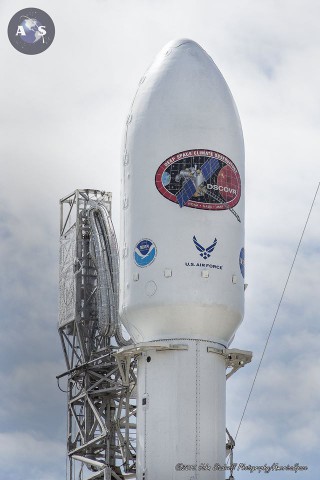
Originally targeted to fly on 31 January, the launch slipped by more than a week until 8 February. Sources at SpaceX advised AmericaSpace that this delay was partly due to the fact that DSCOVR is the Hawthorne, Calif.-based company’s first dedicated mission in conjunction with the U.S. Air Force, who had requested more third-party liability insurance than ordinarily needed for a commercial launch. This required SpaceX senior executives to take additional time to “herd the underwriter cats.” Pressing toward an opening launch attempt, the nine Merlin 1D engines of the Falcon 9 v1.1’s first stage were ignited on 31 January in a standard Static Fire Test. All parameters were deemed satisfactory, allowing SpaceX to move on with the Flight Readiness Review (FRR) and Launch Readiness Review (LRR) milestones.
Sunday dawned fine and sunny in Central Florida, with visibility of 7 miles (11 km), a few cumulus clouds from 3,000-5,000 feet (900-1,500 meters), and scattered altocumulus clouds from 9,000-12,000 feet (2,700-3,600 meters). Temperatures along the Space Coast were reportedly around 21 degrees Celsius (70 degrees Fahrenheit), according to Patrick Air Force Base meteorologists, with a 90 percent probability of acceptable conditions for DSCOVR’s instantaneous launch window at 6:10 p.m. EST—just two minutes after local sunset—threatened only by a slight chance of violating the Cumulus Cloud Rule.
“Mid and low-level clouds are mostly offshore, rotating along the periphery of high pressure circulation,” it was noted. “These clouds are generally not a threat of triggering lightning, keeping the threat of launch weather rule violations very low.” Having said this, it was highlighted that in the event of a scrub on Sunday and a 24-hour turnaround, conditions might significantly worsen to just 40 percent favorable for a 6:07 p.m. T-0 on Monday. “It seems more likely clouds will spread into Central Florida with light rain possible by midday, as a cold front makes its way into northern Florida,” the 45th explained of Monday’s weather outlook. “These clouds are trending to be of sufficient depth over the Spaceport to create a launch risk associated with the Thick Cloud Rule.”
After rollout, the Falcon 9 v1.1 underwent fueling with liquid oxygen and a highly refined form of rocket-grade kerosene, known as “RP-1.” The latter was loaded aboard the vehicle at 2:10 p.m. EST Sunday, following by the onset of liquid oxygen tanking a few minutes before 3 p.m. The cryogenic nature of the oxygen—whose liquid state exists within a temperature range from -221.54 degrees Celsius (-368.77 degrees Fahrenheit) to -182.96 degrees Celsius (-297.33 degrees Fahrenheit)—required the fuel lines of the engines to be chilled, in order to avoid thermally shocking or fracturing them. Fueling was complete by 2:55 p.m., after which all tanks were confirmed at flight levels and the cryogens entered “Replenishment Mode,” whereby they were continuously topped-off until close to T-0.
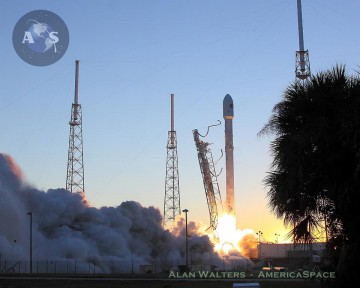
Weather conditions, already exemplary, improved yet further during the course of Sunday afternoon. By the time of the weather briefing at L-1 hour, at just after 5 p.m., they had reached 100 percent favorable, offering SpaceX—at least on the meteorological front—its best possible chance of getting DSCOVR into space on Sunday. The Launch Conductor issued the customary “Go-No Go” polls at 5:50 p.m. and was greeted with a string of “Go” calls, across the board, by which time the precise T-0 had been established at 6:10:12 p.m. The Terminal Countdown got underway at T-10 minutes, during which time the Merlin 1D engines were chilled, ahead of ignition, and all external power utilities from the Ground Support Equipment (GSE) were disconnected.
DSCOVR transitioned from GSE utilities to its own batteries at 6:03 p.m., with the intention that it would draw from internal power until it achieved orbit and was in a position to deploy its electricity-generating solar arrays. At 6:05 p.m., the roughly 90 second process of retracting the “strongback” from the Falcon 9 v1.1 took place, but at this stage flight controllers were already tackling a pair of technical issues: one pertaining to a telemetry item and another caused by an Air Force Range glitch with one of its radar assets. The latter—which Falcon 9 Product Manager John Insprukter explained was necessary for Range Safety operations—could not be brought back online in sufficient time to meet the instantaneous T-0, and Sunday’s attempt was scrubbed. The official point at which the clock stopped was T-2 minutes and 26 seconds. At this stage, the vehicle was in the process of beginning the pressurization of propellant tanks to flight pressures, known as “Pre-Press.”
A revised T-0 of 6:07:49 p.m. EST on Monday was scrubbed early in the day, primarily because the weather outlook carried only a 40 percent probability of acceptable conditions. As a consequence, SpaceX announced that the next attempt would occur no sooner than 6:05 p.m. Tuesday, when the forecast was expected to improve to 80 percent favorable. Unlike Sunday and Monday’s post-sunset windows, that of Tuesday would occur just four minutes before local sundown. Although a frontal boundary had passed through Central Florida—carrying with it isolated thunderstorms and an inch of rain—it was noted by the 45th Space Wing that “low-level stratocumulus clouds and gusty northwesterly winds” had created “a slight concern for a liftoff wind violation,” although it was added that cloud cover was not expected to impair Tuesday’s attempt. Moreover, with the winds expected to subside yet further, conditions for another try on Wednesday evening were expected to be up to 90 percent favorable.
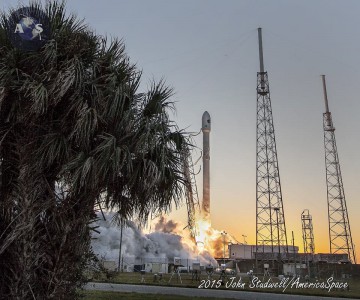
As Tuesday dawned, it brought a forecast of only 70 percent favorable, with Liftoff Winds highlighted as the principal concern. Nevertheless, SpaceX teams picked up the countdown at shortly past 8 a.m. and the weather showed signs of steady improvement throughout the morning, reaching 80 percent favorable by midday. Tanking of the Falcon 9 v1.1 with RP-1 got underway at 2:00 p.m., and within the hour both the fuel and liquid oxygen had been loaded and the latter had entered Replenishment Mode, with white vapor billowing away from the booster.
However, although all Launch Commit Criteria (LCC) were classified as “Green” (“Go”) at 5:05 p.m., the issue of Liftoff Winds remained a concern and the upper-level winds—which do not form part of the Weather LCC guidelines—were gusting at over 115 mph (185 km/h). Thirty minutes later, with the precisely timed T-0 barely a half-hour away, engineers continued to study upper-level wind data, which remained “Red” (“No-Go”). “With the launch of weather balloons,” explained AmericaSpace’s Launch Tracker at 5:37 p.m., “SpaceX engineers are attempting to calculate if a flight solution can be found through the turbulent upper-level winds.” With a final Go/No-Go poll anticipated at T-13 minutes, to allow all members of the flight control team to declare their readiness to support the launch, time was of the essence if the Falcon 9 v1.1 and DSCOVR were to get off the ground.
Unfortunately, the situation in the environs of SLC-40 also worsened, with winds recorded in excess of 31 mph (49.9 km/h), slightly outside the maximum allowable Liftoff Winds criteria of 30 mph (48 km/h). This unhealthy weather situation made a scrub virtually inevitable. At 5:53 p.m., following a balloon report of upper-level winds at 151 percent capacity—far higher than the maximum 100 percent allowed for a launch to go ahead—a definitive “No-Go” was issued by SpaceX Launch Director Ricky Lim. The countdown clock was halted at T-12 minutes and 41 seconds, and the attempt recycled for Wednesday at the slightly earlier time of 6:03:32 p.m., some 7 minutes before sunset.
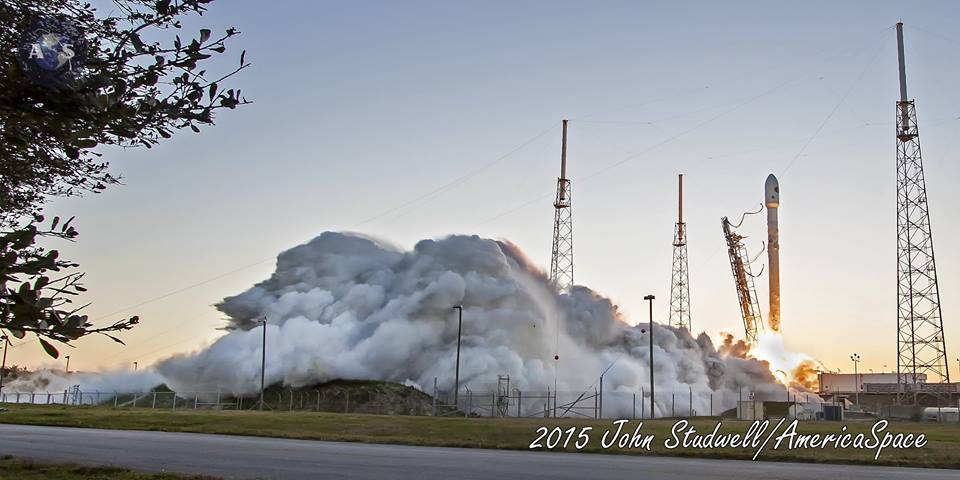
Wednesday morning brought refreshing weather and equally refreshing news. “Cloud cover and surface winds have decreased nicely along the Space Coast and are expected to remain favorable through the countdown tonight,” reported the 45th Space Wing in its 11:00 a.m. summary. “Upper-level winds have also diminished and there is much less shear present over the Spaceport compared to yesterday’s vertical profile. Overall, there is very little risk of a weather violation.” Only the presence of a few stratocumulus clouds, between 2,500-3,500 feet (760-1,000 meters), were noted, with Liftoff Winds posing a smaller than 10 percent threat to a successful launch. Wednesday offered the last opportunity to get DSCOVR into space, before SpaceX and the Range would be forced to stand down until at least 20 February. “This is due to the position of the Moon in its orbit,” AmericaSpace’s Launch Tracker pointed out, “which would produce enough gravitational influence to disturb the flight of DSCOVR on its way out to the L1 orbit.”
In response to Wednesday’s encouraging outlook, for the third time in four days, SpaceX teams set to work fueling the Falcon 9 v1.1 and all tanks—RP-1 and liquid oxygen—had attained flight levels by 2:45 p.m. At this stage, liquid oxygen replenishment got underway, to replace the boiled-off cryogen until close to T-0. As the afternoon wore on, however, it became clear that a pinpoint landing of the booster’s first stage on the Autonomous Spaceport Drone Ship (ASDS), positioned in the Atlantic Ocean, would not be attempted on this mission. The drone ship is designed to operate in all but the most extreme weather conditions … and Wednesday happened to experience just such weather conditions at sea, with waves reaching up to three stories in height, crashing over the decks. Moreover, one of the ASDS’ four azimuth thrusters is out of action, rendering the capability of the enormous barge to maintain station-keeping extremely difficult. SpaceX therefore opted to bring the first stage to a soft oceanic splashdown, which would make its intact recovery unlikely.
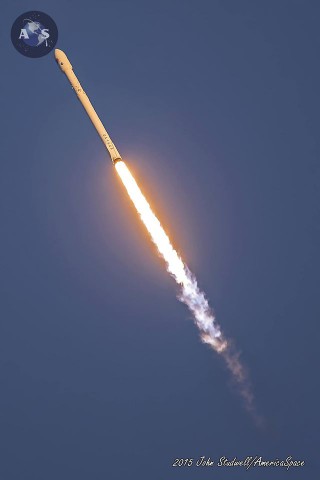
By 5:07 p.m., with less than an hour remaining before T-0, the weather briefing declared that all parameters, including upper-level winds, were within bounds. Indeed, the skies above Cape Canaveral were virtually cloudless. The countdown entered and passed its final “Go/No-Go” polling point of all stations at T-13 minutes, allowing it to head into the Terminal Count at T-10 minutes. During this period, the Merlin 1D engines were chilled, ahead their ignition sequence, and all external GSE power utilities were disconnected. At 5:58 p.m., with about 5 minutes remaining until T-0, the retraction of the strongback got underway and the Flight Termination System (FTS)—which is responsible for destroying the vehicle in the event of a major malfunction during the ascent phase—was placed onto internal power and armed.
At T-2 minutes and 15 seconds, having passed beyond the scrub points of both Sunday’s and Tuesday’s foiled launch attempts, the first stage propellant tanks attained flight pressure and the nine Merlins were purged with gaseous nitrogen. Sixty seconds before launch, “Range Green” was declared to signify the security of the overall launch area, and the SLC-40 complex’s “Niagara” deluge system of 53 nozzles came to life, flooding the pad and flame trench with 30,000 gallons (113,500 liters) of water, per minute, to suppress acoustic energy radiating from the engine exhausts.
At T-3 seconds, the Merlins roared to life, ramping up to a combined thrust of 1.3 million pounds (590,000 kg). Following computer-commanded health checks, the stack was released from SLC-40 to begin SpaceX’s second mission of 2015. Immediately after clearing the tower, the booster executed a combined pitch, roll, and yaw program maneuver to establish itself onto the proper 35-degree flight azimuth, heading north-northeast of the Cape, to deliver DSCOVR into space. Eighty seconds into the climb uphill, the vehicle exceeded the speed of sound and experienced a period of maximum aerodynamic duress—colloquially dubbed “Max Q”—on its airframe. At about this time, the Merlin 1D Vacuum engine of the second stage underwent a chill-down protocol, ahead of its own ignition later in the ascent. At 6:05 p.m., 130 seconds after liftoff, two of the first-stage engines throttled back, in order to reduce the rate of acceleration at the point of Main Engine Cutoff (MECO).
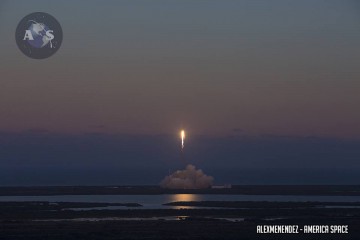
Finally at T+2 minutes and 58 seconds, at 6:06:10 p.m., the seven remaining engines were shut down, and, a few seconds later, the first stage separated from the rapidly ascending stack. With the first stage gone, the turn then came for the Falcon 9 v1.1’s restartable second stage, whose Merlin 1D Vacuum engine—with a maximum thrust of 180,000 pounds (81,600 kg)—roared to life at 6:06:21 p.m. to support the first of two discrete “burns”.
Thirty seconds later, the bulbous, two-piece (or “bisector”) Payload Fairing (PLF) was jettisoned, its departure clearly and spectacularly visible to long-range tracking cameras on the ground. “At this height in the atmosphere, there is no threat of damage to the delicate satellite from the rushing air,” noted AmericaSpace’s Launch Tracker, and after more than a decade of development and delay, DSCOVR—originally named “Triana” and intended for a somewhat different purpose—savored the environment of space for the first time. The first burn of the Falcon 9 v1.1’s second stage ended, as planned, at 6:13:07 p.m., a little under 10 full minutes since departing SLC-40. The vehicle then coasted for about 16 minutes, before the commencement of the second burn at 6:29:32 p.m. This lasted a little more than 60 seconds, and, at its conclusion, the stack coasted for five minutes and DSCOVR was “spun-up” and set free at 6:40:02 p.m., some 36 minutes and 32 seconds into the mission. The small spacecraft is now on its own to complete the 110-day voyage to reach the L1 Lagrange Point and should be on-station and ready for early operations by the end of May.
Want to keep up-to-date with all things space? Be sure to “Like” AmericaSpace on Facebook and follow us on Twitter: @AmericaSpace
Missions » DSCOVR »



It was really cool watching SpaceX’s first Beyond Earth Mission. I hope to see many more in the future!
Kudos – yet again – to SpaceX for a successful launch and deployment of DSCOVR. The accompanying photographs by John Studwell are spectacular as well.